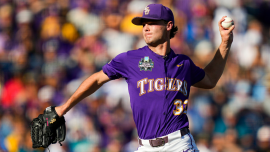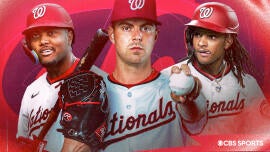
On Sunday, the Washington Nationals fired general manager Mike Rizzo and manager Davey Martinez. While both dismissals were merited (the Nationals haven't had a .500 season since winning the 2019 World Series) they were executed at an odd time on the calendar. Come this Sunday, a week after ousting the organization's top baseball operations decision maker, the Nationals will make the No. 1 selection on the amateur draft for the third time in franchise history. (They previously chose first in both 2009 and 2010, netting ace Stephen Strasburg and outfielder Bryce Harper in the process.)
With Rizzo ousted, the Nationals elevated assistant general manager Mike DeBartolo -- a member of the front office since 2012 -- as their interim baseball operations leader.
"Mike DeBartolo is a smart and thoughtful executive, and we're fortunate to have him as part of our organization," owner Mike Lerner said in a statement. "As we hold the No. 1 overall pick in this year's MLB Draft and look ahead to the trade deadline, we are confident in his ability to lead the baseball operations staff through these next, important months."
Given the timing of the switch to DeBartolo, it's only fair to wonder: will Rizzo's departure change the Nationals' approach to the draft? For some perspective on What It All Means, let's turn to a few handy, dandy subheadings.
2025 MLB Mock Draft: New Nationals GM gets the No. 1 pick, college catcher sneaks into top 5
Mike Axisa

1. Past precedent
For as jarring as Rizzo's firing is at first blush, it's not the first time something like this has happened: the Kansas City Royals dismissed Allard Baird six days before making the No. 1 pick in the 2006 MLB Draft. The Royals subsequently agreed to hire Dayton Moore, then an assistant GM with the Atlanta Braves, but his start date wasn't until after the draft -- and he wasn't afforded any input on what Kansas City did with the selection.
In that case, all the decision-making weight was placed on the shoulders of scouting director Deric Ladnier and the rest of the scouting department.
"I know Deric very well and Deric is a very well-respected baseball person in the game. He has a core group of people there that I know and trust as well. They'll make the right pick for the Kansas City Royals," Moore said at the time.
Ladnier and the Royals selected right-hander Luke Hochevar with the pick. While Hochevar would go on to amass the 15th-most Wins Above Replacement of that first round -- well behind names like Clayton Kershaw, Max Scherzer, and Evan Longoria -- he was, at least, part of the 2015 World Series winning squad. He even threw 10 ⅔ scoreless innings in relief that postseason.
It's unclear how, exactly, the Nationals will divide decision-making power for the draft. Will DeBartolo make the final call, or will he defer to Danny Haas and the scouting department? Rizzo had a perception, fair or not, as being more hands-on based on his own experience. (Remember, Rizzo was a scout who served as the Arizona Diamondbacks scouting director before joining the Nationals front office.) It's possible that was a mischaracterization; it's also possible that the effective chain of command within the scouting department remains largely unaffected by those dismissals.
2. Anderson has been favored
Although Oklahoma prep infielder Ethan Holliday is the most famous player in the class, he wasn't considered the favorite to go No. 1 when I polled executives in June. Rather, the expectation at the time was that the Nationals would pick LSU left-hander Kade Anderson.
The sportsbooks have a similar prediction: DraftKings lists Anderson as the favorite at -220, while FanDuel has him at -320.
Now, it's important to contextualize that information. While the Nationals may indeed select Anderson -- and may have also done so under Rizzo -- the reality is that a decision probably hasn't been made yet. Scouting directors are quick to point out that these calls often arrive later than you'd expect. That's because all involved parties don't stop posturing in negotiations until it's nut-cutting time.
Anderson would be a defensible selection. He's an SEC-vetted southpaw with a broad arsenal and middle-of-the-rotation potential who could move quickly through the minor leagues. That last part is notable since it separates Anderson from my No. 1 prospect in this year's draft, Oklahoma prep shortstop Eli Willits, who won't celebrate his 18th birthday until December and is unlikely to reach the majors anytime soon.
It's easy to write that the Nationals should have the patience -- the discipline, even -- to take the player with the most realistic upside, no matter what. But oftentimes, in this industry and on this planet, idealism gives way to pragmatism. In this case, the Nationals may choose a different path because, let's face it, they've been noncompetitive for long enough that people are losing their jobs.
Besides, the reality is that the Nationals can already hear the clock ticking on their core. All-Star lefty MacKenzie Gore is a couple seasons away from free agency, and shortstop CJ Abrams isn't far behind. Star outfielder James Wood, meanwhile, could qualify for arbitration in winter 2027. If the Nationals want to make a push with those three, they need to start making win-now moves sooner than later.
The Nationals have MLB Draft's No. 1 pick and a new GM -- is that enough to turn their rebuild around?
Dayn Perry

3. The wild-card factor
Don't forget that ownership can have a say in all this, too. Theoretically, if they apply pressure to the remaining front office to take someone on a shorter trajectory to the majors, then the odds are the Nationals will take someone on a shorter trajectory to the majors.
With that written, Rizzo's tenure with the Nationals included instances where he threatened to quit in order to persuade the ownership group in a different direction. And so, it's fair to note that relationships matter, too, both between executives and owners and between agents and organizations.
This is a convenient time to acknowledge that both Anderson and Holliday are represented by superagent Scott Boras. That isn't particularly novel within itself -- Boras represents a lot of elite talents -- but the Lerner family is known to have (or, at minimum, to have had) a good working relationship with him in the past. To wit, late patriarch Ted Lerner once admitted that a conversation with Boras inspired him to tank for the draft picks that became Strasburg and Harper.
"That kind of started a process," Boras told the Washington Post in 2016. "I told him, 'Your objective is, you got to get the top picks, because the top picks that are coming are extraordinary. I would not follow that plan [adding through free agency], because you have too many holes and you don't have a minor league system. If you really want to do what's best for your franchise, I would focus on how I'm going to get those draft picks. When I look at this system, I wouldn't be spending a great deal of money on major league players.'"
It's unclear if the rest of the Lerner family shares that kind of relationship with Boras. But if they do, it's at least possible that it -- in addition to the other factors in play described above -- help determine what the Nationals do when they're on the clock Sunday.







-3.png)



